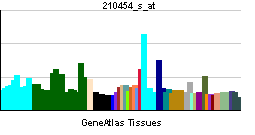KCNJ6
| Potassium inwardly-rectifying channel, subfamily J, member 6 | |||||||||||
|---|---|---|---|---|---|---|---|---|---|---|---|
| Identifiers | |||||||||||
| Symbols | KCNJ6 ; BIR1; GIRK2; KATP2; KCNJ7; KIR3.2; MGC126596; hiGIRK2 | ||||||||||
| External IDs | Template:OMIM5 Template:MGI HomoloGene: 1688 | ||||||||||
| |||||||||||
| RNA expression pattern | |||||||||||
 | |||||||||||
| More reference expression data | |||||||||||
| Orthologs | |||||||||||
| Template:GNF Ortholog box | |||||||||||
| Species | Human | Mouse | |||||||||
| Entrez | n/a | n/a | |||||||||
| Ensembl | n/a | n/a | |||||||||
| UniProt | n/a | n/a | |||||||||
| RefSeq (mRNA) | n/a | n/a | |||||||||
| RefSeq (protein) | n/a | n/a | |||||||||
| Location (UCSC) | n/a | n/a | |||||||||
| PubMed search | n/a | n/a | |||||||||
Potassium inwardly-rectifying channel, subfamily J, member 6, also known as KCNJ6 or Kir3.2, is a human gene.[1]
Potassium channels are present in most mammalian cells, where they participate in a wide range of physiologic responses. The protein encoded by this gene is an integral membrane protein and inward-rectifier type potassium channel. The encoded protein, which has a greater tendency to allow potassium to flow into a cell rather than out of a cell, is controlled by G-proteins and may be involved in the regulation of insulin secretion by glucose. It associates with two other G-protein-activated potassium channels to form a heteromultimeric pore-forming complex.[1]
See also
References
Further reading
- Kubo Y, Adelman JP, Clapham DE; et al. (2006). "International Union of Pharmacology. LIV. Nomenclature and molecular relationships of inwardly rectifying potassium channels". Pharmacol. Rev. 57 (4): 509–26. doi:10.1124/pr.57.4.11. PMID 16382105.
- Patil N, Cox DR, Bhat D; et al. (1995). "A potassium channel mutation in weaver mice implicates membrane excitability in granule cell differentiation". Nat. Genet. 11 (2): 126–9. doi:10.1038/ng1095-126. PMID 7550338.
- Ferrer J, Nichols CG, Makhina EN; et al. (1995). "Pancreatic islet cells express a family of inwardly rectifying K+ channel subunits which interact to form G-protein-activated channels". J. Biol. Chem. 270 (44): 26086–91. PMID 7592809.
- Tsaur ML, Menzel S, Lai FP; et al. (1995). "Isolation of a cDNA clone encoding a KATP channel-like protein expressed in insulin-secreting cells, localization of the human gene to chromosome band 21q22.1, and linkage studies with NIDDM". Diabetes. 44 (5): 592–6. PMID 7729621.
- Sakura H, Bond C, Warren-Perry M; et al. (1995). "Characterization and variation of a human inwardly-rectifying-K-channel gene (KCNJ6): a putative ATP-sensitive K-channel subunit". FEBS Lett. 367 (2): 193–7. PMID 7796919.
- Lesage F, Duprat F, Fink M; et al. (1994). "Cloning provides evidence for a family of inward rectifier and G-protein coupled K+ channels in the brain". FEBS Lett. 353 (1): 37–42. PMID 7926018.
- Liao YJ, Jan YN, Jan LY (1996). "Heteromultimerization of G-protein-gated inwardly rectifying K+ channel proteins GIRK1 and GIRK2 and their altered expression in weaver brain". J. Neurosci. 16 (22): 7137–50. PMID 8929423.
- Signorini S, Liao YJ, Duncan SA; et al. (1997). "Normal cerebellar development but susceptibility to seizures in mice lacking G protein-coupled, inwardly rectifying K+ channel GIRK2". Proc. Natl. Acad. Sci. U.S.A. 94 (3): 923–7. PMID 9023358.
- Ohira M, Seki N, Nagase T; et al. (1997). "Gene identification in 1.6-Mb region of the Down syndrome region on chromosome 21". Genome Res. 7 (1): 47–58. PMID 9037601.
- Huang CL, Jan YN, Jan LY (1997). "Binding of the G protein betagamma subunit to multiple regions of G protein-gated inward-rectifying K+ channels". FEBS Lett. 405 (3): 291–8. PMID 9108307.
- Dahmane N, Ghezala GA, Gosset P; et al. (1998). "Transcriptional map of the 2.5-Mb CBR-ERG region of chromosome 21 involved in Down syndrome". Genomics. 48 (1): 12–23. doi:10.1006/geno.1997.5146. PMID 9503011.
- Inanobe A, Horio Y, Fujita A; et al. (2000). "Molecular cloning and characterization of a novel splicing variant of the Kir3.2 subunit predominantly expressed in mouse testis". J. Physiol. (Lond.). 521 Pt 1: 19–30. PMID 10562331.
- Hibino H, Inanobe A, Tanemoto M; et al. (2000). "Anchoring proteins confer G protein sensitivity to an inward-rectifier K(+) channel through the GK domain". EMBO J. 19 (1): 78–83. doi:10.1093/emboj/19.1.78. PMID 10619846.
- Schoots O, Wilson JM, Ethier N; et al. (2000). "Co-expression of human Kir3 subunits can yield channels with different functional properties". Cell. Signal. 11 (12): 871–83. PMID 10659995.
- Hattori M, Fujiyama A, Taylor TD; et al. (2000). "The DNA sequence of human chromosome 21". Nature. 405 (6784): 311–9. doi:10.1038/35012518. PMID 10830953.
- Jelacic TM, Kennedy ME, Wickman K, Clapham DE (2000). "Functional and biochemical evidence for G-protein-gated inwardly rectifying K+ (GIRK) channels composed of GIRK2 and GIRK3". J. Biol. Chem. 275 (46): 36211–6. doi:10.1074/jbc.M007087200. PMID 10956667.
- Chen L, Kawano T, Bajic S; et al. (2002). "A glutamate residue at the C terminus regulates activity of inward rectifier K+ channels: implication for Andersen's syndrome". Proc. Natl. Acad. Sci. U.S.A. 99 (12): 8430–5. doi:10.1073/pnas.122682899. PMID 12034888.
- Lavine N, Ethier N, Oak JN; et al. (2003). "G protein-coupled receptors form stable complexes with inwardly rectifying potassium channels and adenylyl cyclase". J. Biol. Chem. 277 (48): 46010–9. doi:10.1074/jbc.M205035200. PMID 12297500.
- Strausberg RL, Feingold EA, Grouse LH; et al. (2003). "Generation and initial analysis of more than 15,000 full-length human and mouse cDNA sequences". Proc. Natl. Acad. Sci. U.S.A. 99 (26): 16899–903. doi:10.1073/pnas.242603899. PMID 12477932.
- Ivanina T, Rishal I, Varon D; et al. (2003). "Mapping the Gbetagamma-binding sites in GIRK1 and GIRK2 subunits of the G protein-activated K+ channel". J. Biol. Chem. 278 (31): 29174–83. doi:10.1074/jbc.M304518200. PMID 12743112.
External links
- KCNJ6+protein,+human at the US National Library of Medicine Medical Subject Headings (MeSH)
| Stub icon | This membrane protein–related article is a stub. You can help Wikipedia by expanding it. |
This article incorporates text from the United States National Library of Medicine, which is in the public domain.